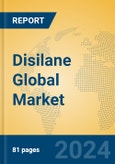Introduction
Disilane (Si₂H₆) is a highly reactive, colorless gas used as a precursor in chemical vapor deposition (CVD) processes for semiconductor manufacturing. The industry is characterized by its critical role in producing high-purity silicon films for logic ICs, DRAM, and 3D NAND flash, with a focus on ultra-high-purity grades. Key trends include advancements in low-temperature deposition technologies, sustainable production methods, and integration with next-generation semiconductor processes. The market is driven by demand for advanced electronics, 5G infrastructure, and artificial intelligence applications, particularly in Asia Pacific.Market Size and Growth Forecast
The global Disilane market was valued at USD 290-530 million in 2024, with an estimated CAGR of 8.0%-12.0% from 2025 to 2030, driven by demand for semiconductors.Regional Analysis
- North America is projected to grow at a CAGR of 7.0%-10.0%, with the U.S. leading due to its semiconductor and AI industries, emphasizing high-purity disilane.
- Europe is expected to achieve a CAGR of 6.0%-9.0%, with Germany driving demand, focusing on automotive electronics and 5G applications.
- Asia Pacific is anticipated to record the highest growth at a CAGR of 9.0%-13.0%, driven by China, South Korea, and Taiwan, where semiconductor production fuels demand.
- Rest of the World, including Brazil and South Africa, is expected to grow at a CAGR of 6.5%-9.5%, with potential in electronics manufacturing.
Application Analysis
- Logic IC applications are estimated to grow at a CAGR of 9.0%-12.0%, driven by disilane’s use in advanced chip fabrication, with trends toward smaller node processes (e.g., 3nm).
- DRAM applications are projected to expand at a CAGR of 7.0%-10.0%, supported by demand for memory in data centers, with innovations in high-density modules.
- 3D NAND flash applications are anticipated to grow at a CAGR of 8.0%-11.0%, focusing on high-layer storage devices, with trends toward 176-layer architectures.
- Other applications, including solar cells, are expected to grow at a CAGR of 6.0%-9.0%, driven by thin-film deposition in photovoltaics.
Key Market Players
Air Liquide, based in Paris, France, is a global leader in disilane production, offering ultra-high-purity solutions for semiconductors, known for its advanced gas technologies.SK specialty Co. Ltd, headquartered in Seoul, South Korea, specializes in disilane for logic ICs, emphasizing innovative CVD precursors.
Mitsui Chemicals, based in Tokyo, Japan, produces disilane for memory applications, focusing on high-purity manufacturing.
TSCC, headquartered in Taipei, Taiwan, supplies disilane for semiconductor processes, known for its regional supply chain expertise.
APK, based in Seoul, South Korea, offers disilane for electronics, emphasizing scalable production.
WONIK MATERIALS, headquartered in Gyeonggi-do, South Korea, produces disilane for advanced semiconductors, focusing on high-quality precursors.
REC Silicon, based in Moses Lake, Washington, USA, provides disilane for semiconductor and solar applications, known for its sustainable processes.
Anhui Agsun Electronic New Materials, headquartered in Anhui, China, supplies disilane for electronics, focusing on cost-competitive production.
Yantai Wanhua Electronic Materials, based in Yantai, China, produces disilane for semiconductors, emphasizing innovative material solutions.
Zhejiang Zhongning Silicon Industry, headquartered in Zhejiang, China, offers disilane for advanced electronics, known for its scalable operations.
Porter’s Five Forces Analysis
- The threat of new entrants is low; high capital costs and stringent purity requirements for disilane production create significant barriers.
- The threat of substitutes is low; alternative silicon precursors like silane are less efficient, maintaining disilane’s dominance in advanced CVD processes.
- Buyer power is moderate; large semiconductor firms like TSMC negotiate pricing, but disilane’s critical role limits buyer leverage.
- Supplier power is moderate; raw materials like silicon face price volatility, increasing supplier influence.
- Competitive rivalry is high; key players differentiate through purity levels, sustainable production, and application-specific innovations.
Market Opportunities and Challenges
Opportunities
- Rising demand for advanced semiconductors drives disilane adoption.
- Expansion of 5G and AI infrastructure enhances market growth.
- Emerging markets in Asia Pacific offer expansion opportunities due to electronics growth.
Challenges
- Stringent safety regulations on disilane handling increase compliance costs.
- High energy costs in purification processes hinder cost competitiveness.
- Supply chain disruptions for silicon raw materials impact market scalability.
Growth Trend Analysis
The Disilane market is growing rapidly, driven by demand for advanced semiconductors. In August 2024, Hubei Xunsheng Semiconductor Materials announced a 40-ton disilane project, set to be operational by April 2025, with a 588 million Yuan investment. In December 2024, Yantai Wanhua Electronic Materials launched a 50-ton disilane production line, achieving 5N and 7N purity levels, and is developing a 140-ton silane-based project. On April 14, 2025, Hubei Xunsheng’s 1,184-ton silane series project, including 184 tons of disilane, was approved, with a 5 billion Yuan investment. These developments align with a projected CAGR of 8.0%-12.0% through 2030, reflecting disilane’s critical role in semiconductor manufacturing.This product will be delivered within 1-3 business days.
Table of Contents
Companies Mentioned
- Air Liquide
- SK specialty Co. Ltd.
- Mitsui Chemicals
- TSCC
- APK
- WONIK MATERIALS
- REC Silicon
- Anhui Agsun Electronic New Materials
- Yantai Wanhua Electronic Materials
- Zhejiang Zhongning Silicon Industry








